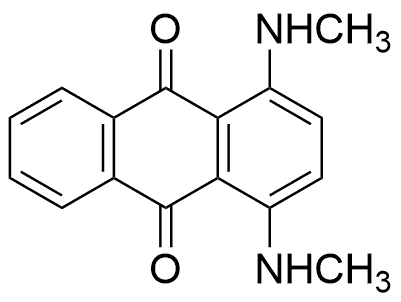Disperse blue 14 is widely utilized in research focused on:
- Dyeing and Printing Textiles: This compound is primarily used in the textile industry for dyeing synthetic fibers like polyester and nylon, providing vibrant blue hues that are resistant to fading.
- Colorants in Plastics: It serves as a colorant in the plastics industry, enhancing the aesthetic appeal of products while maintaining durability and stability under various conditions.
- Research in Organic Electronics: Disperse blue 14 is explored in the development of organic electronic materials, contributing to advancements in organic light-emitting diodes (OLEDs) and organic solar cells.
- Biological Studies: The compound is used in biological research to study its interactions with cellular components, aiding in the understanding of cellular processes and potential therapeutic applications.
- Environmental Monitoring: It is applied in environmental studies to track dye pollution in water bodies, helping researchers assess the impact of textile waste on ecosystems.
General Information
Properties
Safety and Regulations
Applications
Disperse blue 14 is widely utilized in research focused on:
- Dyeing and Printing Textiles: This compound is primarily used in the textile industry for dyeing synthetic fibers like polyester and nylon, providing vibrant blue hues that are resistant to fading.
- Colorants in Plastics: It serves as a colorant in the plastics industry, enhancing the aesthetic appeal of products while maintaining durability and stability under various conditions.
- Research in Organic Electronics: Disperse blue 14 is explored in the development of organic electronic materials, contributing to advancements in organic light-emitting diodes (OLEDs) and organic solar cells.
- Biological Studies: The compound is used in biological research to study its interactions with cellular components, aiding in the understanding of cellular processes and potential therapeutic applications.
- Environmental Monitoring: It is applied in environmental studies to track dye pollution in water bodies, helping researchers assess the impact of textile waste on ecosystems.
Documents
Safety Data Sheets (SDS)
The SDS provides comprehensive safety information on handling, storage, and disposal of the product.
Product Specification (PS)
The PS provides a comprehensive breakdown of the product’s properties, including chemical composition, physical state, purity, and storage requirements. It also details acceptable quality ranges and the product's intended applications.
Certificates of Analysis (COA)
Search for Certificates of Analysis (COA) by entering the products Lot Number. Lot and Batch Numbers can be found on a product’s label following the words ‘Lot’ or ‘Batch’.
*Catalog Number
*Lot Number
Certificates Of Origin (COO)
This COO confirms the country where the product was manufactured, and also details the materials and components used in it and whether it is derived from natural, synthetic, or other specific sources. This certificate may be required for customs, trade, and regulatory compliance.
*Catalog Number
*Lot Number
Safety Data Sheets (SDS)
The SDS provides comprehensive safety information on handling, storage, and disposal of the product.
DownloadProduct Specification (PS)
The PS provides a comprehensive breakdown of the product’s properties, including chemical composition, physical state, purity, and storage requirements. It also details acceptable quality ranges and the product's intended applications.
DownloadCertificates of Analysis (COA)
Search for Certificates of Analysis (COA) by entering the products Lot Number. Lot and Batch Numbers can be found on a product’s label following the words ‘Lot’ or ‘Batch’.
*Catalog Number
*Lot Number
Certificates Of Origin (COO)
This COO confirms the country where the product was manufactured, and also details the materials and components used in it and whether it is derived from natural, synthetic, or other specific sources. This certificate may be required for customs, trade, and regulatory compliance.


